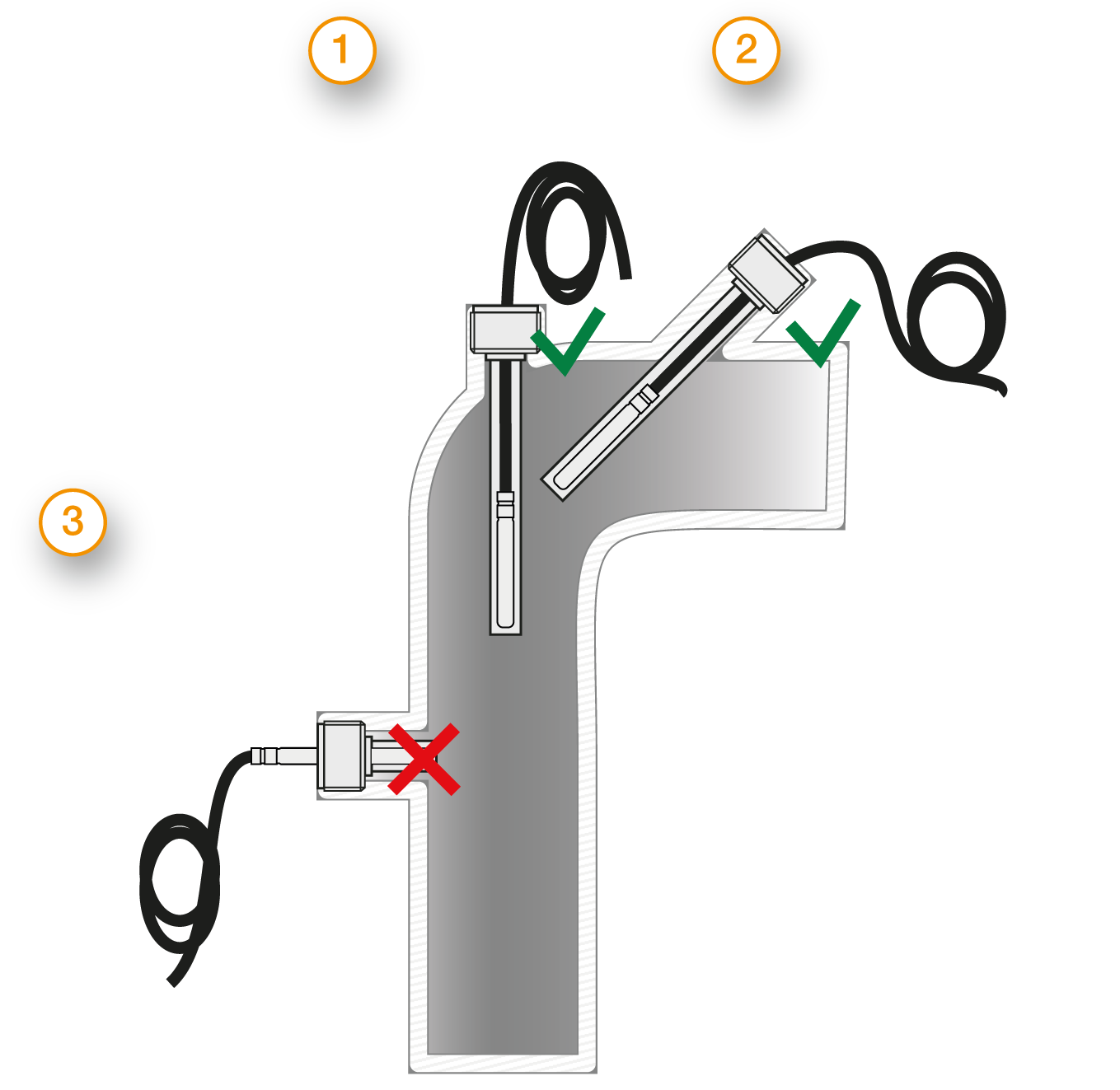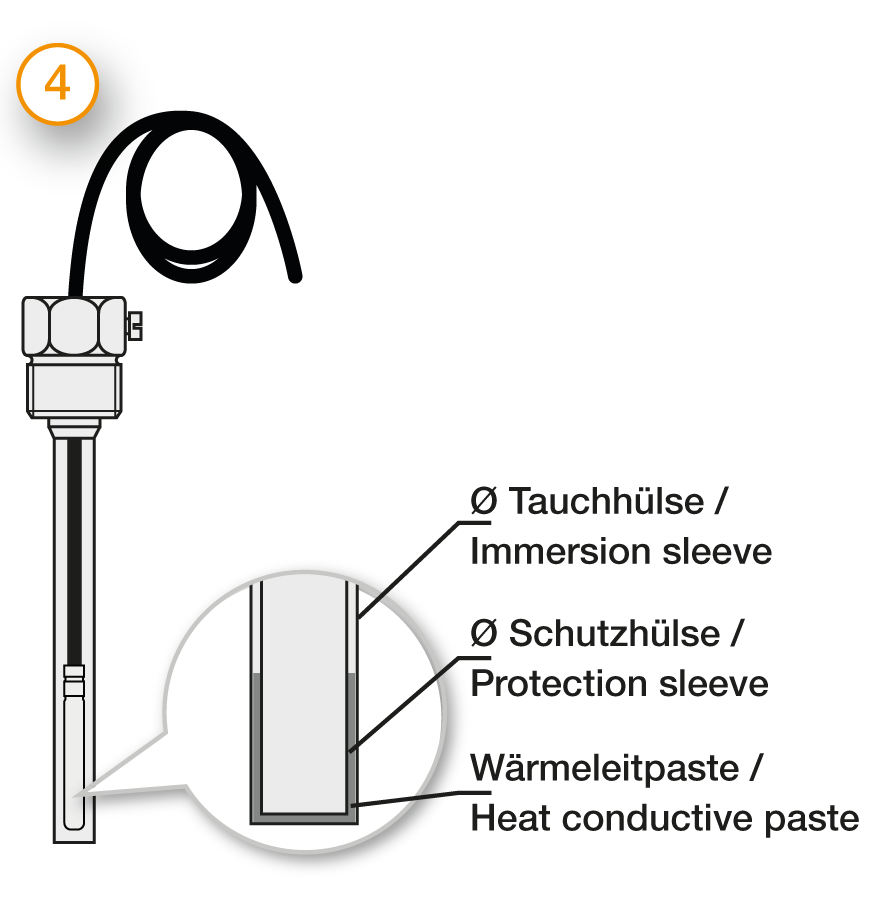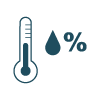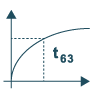Prices plus VAT plus shipping costs of 4,95 € to GER (incl. VAT)
Delivery time 5 Workdays to NL, BE, AT (GER -1 workdays)

Jeder Fühler benötigt eine Mindest-Eintauchtiefe, um die Temperatur des zu messenden Mediums annehmen und korrekt messen zu können. Faustformel: optimalerweise sollte die Eintauchtiefe 10-mal dem Schutzhülsendurchmesser entsprechen, mindest sollte jedoch ein 5-facher Wert verwendet werden.







Bei Temperaturmessungen in Festkörpern oder wenn der Fühler in einer Tauchhülse montiert ist, verlangsamt die den Fühler umgebende Luft die Wärmeleitung vom Medium zum Fühler. Dadurch wird auch die Temperaturmessung verlangsamt und führt im Extremfall zu falschen Temperaturmesswerten. Achten Sie bitte deshalb darauf, dass der Temperaturfühler wärmetechnisch bestmöglich an Ihr Messmedium angekoppelt ist, d.h. wählen Sie den Hülsendurchmesser so aus, dass der Luftspalt so klein wie möglich wird.


Bitte stellen Sie sicher, dass die technischen Daten der Anschlussleitung, insbesondere hinsichtlich Temperatur und IP-Schutzklasse, zu Ihrer Applikation passen. Detailierte Informationen finden Sie in unseren Datenblättern.
Temperaturbereiche unserer Leitungen:
PVC -30 °C bis +90 °C









Bitte beachten Sie den spezifizierten Temperaturbereich des Stecker / der Aderendenhülsen
isolierte Aderendhülsen: bis 80 °C
Mini-TE-Stecker: bis 220 °C
TE-Stecker: bis 220 °C


| Ihr passender Hutschienen-Transmitter: | ||
| C - Länge Schutzhülse: | ||
| D - Durchmesser Schutzhülse: | ||
| E - Material Anschlussleitung: | ||
| F - Länge Leitung: | ||
| G - Stecker: | ||
| H - Knickschutz: | ||
| Menge: |
- Order number: 803550-1191





Advantages
- We are ready to deliver: All information here
- Advice directly from experts
- Quality directly from the manufacturer
- Long-term stable temperature probes over years
- B2B customers welcome: All information here

Our employee will be happy to help you:
Julian Mäntele
Tel.: +49 (0)7653 96 59 771
E-Mail: jmaentele@testo-sensor.de
Active cable thermocouples are equipped with a temperature transmitter in DIN rail form. They detect temperatures in the range from -30 °C to 90 °C and convert the thermoelectric voltage into a standardized signal (mA). This means that the temperature measurement signals can always be transmitted safely, easily and even over longer distances to your controller or display. Cable thermocouples with PVC cable are usually the most cost-effective solution. If other temperatures or higher flexibility are required, cables made of silicone, glass silk or PFA are used.
________________________________
The APAQ R130 TC for thermocouples is a DIN rail transmitter for installation on standard DIN rails according to DIN EN50022. The sophisticated product design leaves sufficient space for mounting. It is optimally designed for use in plant and machine construction and is characterized by high accuracy, reliability, long-term stability and its robust product design. The transmitter is extremely insensitive to external influences such as vibration and EMC interference. Installation and commissioning are particularly user-friendly. For example, parameterization can be carried out wirelessly, conveniently and easily via the cell phone app using NFC technology. The monitoring functions such as sensor break monitoring, sensor short-circuit and measuring range monitoring can also be activated via this.
Here you can find our downloads for Hat rail transmitter for thermocouples APAQ-R130
Hat rail transmitter - Special features | ||||||||||||||||
| Inputs and outputs | Input: thermocouples Output: 4 to 20mA, temperature linear output signal | |||||||||||||||
| Accuracy & Long-term stability | Accuracy: depending on thermocouple Long-term stability: max drift of ±0.05°C or ±0.05% of span |year | |||||||||||||||
| Design | Robust - vibration and shock resistant design Suitable for hat rails according to DIN EN50022 Compact housing design Facilitated mounting | |||||||||||||||
| Parametrization | Configuration - wireless via NFC technology Free app for Iphone, Android & Huawei Parameterization templates for fast mass configuration Simple configuration with "copy and paste" in no time at all  | |||||||||||||||
| Alarm function | configurable via app Sensor break monitoring Sensor short circuit Measuring range monitoring | |||||||||||||||
Hat rail transmitter - Input Thermocouple | ||||||||||||||||
| Measuring element | Material / Raw Material | Norm | Maximum configurable measuring range | Min. Span | Accuracy | |||||||||||
| Type B | Pt30Rh-Pt6Rh | IEC 60584 | 0 °C to +1820 °C 32 °F to +3308 °F | +700 °C | +1292 °F | +100 °C to +400 °C: ±10 °C >400 °C: ±2 °C / 0,2% 1} | |||||||||||
| Type E | NiCr-CuNi | IEC 60584 | -270 °C to +1000 °C -454 °F to +1832 °F | +50 °C | +122 °F | ±1 °C| ±0,2 % 1} | |||||||||||
| Type J | Fe-CuNi | IEC 60584 | -210 °C to +1200 °C -346 °F to +2192 °F | +50 °C | +122 °F | ±1 °C| ±0,2 % 1} | |||||||||||
| Type K | NiCr-Ni | IEC 60584 | -270 °C to +1300 °C -454 °F to +2372 °F | +50 °C | +122 °F | ±1 °C| ±0,2 % 1} | |||||||||||
| Type N | NiCrSi-NiSi | IEC 60584 | -100 °C to +1300 °C -148 °F to +2372 °F | +100 °C | +212 °F | ±1 °C| ±0,2 % 1} | |||||||||||
| Type N | NiCrSi-NiSi | IEC 60584 | -270 °C to -100 °C -418 °F to +148 °F | +100 °C | +212 °F | ±2 °C 1} | |||||||||||
| Type R | Pt13Rh-Pt | IEC 60584 | -50 °C to +1750 °C -58 °F to +3182 °F | +300 °C | +572 °F | ±2 °C| ±0,2 % 1} | |||||||||||
| Type S | Pt10Rh-Pt | IEC 60584 | -50 °C to +1750 °C -58 °F to +3182 °F | +300 °C | +572 °F | ±2 °C| ±0,2 % 1} | |||||||||||
| Type T | Cu-CuNi | IEC 60584 | -270 °C to +400 °C -454 °F to +752 °F | +50 °C | +122 °F | ±2 °C| ±0,2 % 1} | |||||||||||
| 1} of span (cold junction compensation error is not included) | ||||||||||||||||
| Input impedance | >10 MΩ | |||||||||||||||
| Max. wire loop resistance | 5 kΩ | |||||||||||||||
| Cold Junction Compensation | Internal or external | |||||||||||||||
Hat rail transmitter - General information about the input | ||||||||||||||||
| Zero adjustment | Within measuring range | |||||||||||||||
Hat rail transmitter - Output | ||||||||||||||||
| Output type | analog, temperature linear for TC |  | ||||||||||||||
| Output signal (mA) | 4 to 20 | |||||||||||||||
| Parametrization / Scaling | Configurable via NFC | |||||||||||||||
| Load | 818 Ω at 24 VDC | |||||||||||||||
| Connection type | 2-wire | |||||||||||||||
Hat rail transmitter - Time response | ||||||||||||||||
| Closing time / Update time (Inor) | ~150 - 300 | |||||||||||||||
| Heating period | After approx. 20 min. the typical accuracy is reached | |||||||||||||||
| Signal attenuation / Ajustable output filtering (Inor) | 0,4 to 26 adjustable via App | |||||||||||||||
| Measuring cycle | < 1 | |||||||||||||||
Hat rail transmitter - Sensor monitoring & sensor error | ||||||||||||||||
| Sensor break / Short circuit | Upscale (≥21.0 mA) or Downscale (≤3.6 mA) | |||||||||||||||
| Sensor failure effects (Inor) | according to NAMUR NE43 | |||||||||||||||
Hat rail transmitter - Accuracy and stability | ||||||||||||||||
| Temperature influence | ||||||||||||||||
| TC Type B, E, J, K, R, S, T | see table below | |||||||||||||||
| TC Type N (-100...+1300 °C) | ±0,01 % < 4000 Ω 2} < ±0,02 % of span per °C | |||||||||||||||
| TC Type N (-270...-100 °C) | ±0,01 % of span per °C | |||||||||||||||
| Influence of the sensor cable | ||||||||||||||||
| Thermocouples and Voltage | Negligible | |||||||||||||||
| Further data | ||||||||||||||||
| Supply voltage influence | <±0.005 % of span per volt | |||||||||||||||
| Long-term drift | ±0.05 % of span per year | |||||||||||||||
Hat rail transmitter - Type | ||||||||||||||||
| Dimensions | See drawing |  | ||||||||||||||
| Material | Flammability | V0/HB, RoHS compliant | |||||||||||||||
| Mounting | 35 mm hat rail according to DIN 50022 / EN 60715 | |||||||||||||||
| Connection | Single wires, max. 1,5 mm², AWG 16 | |||||||||||||||
| Weight | 40 | All dimensions in mm | ||||||||||||||
Hat rail transmitter - General data | ||||||||||||||||
| Isolation | none | |||||||||||||||
| Supply Voltage (VDC) | 8 to 32, polarity protected | |||||||||||||||
Hat rail transmitter - Ambient conditions | ||||||||||||||||
| Ambient Temperatur | Storage: -40 °C to +85 °C | -40 °F to +185 °F Operating: -40 °C to +85 °C | -40 °F to +185 °F | |||||||||||||||
| Humidity | 0 to 98 (non-condensing) | |||||||||||||||
| Protection | Housing IP20 | Anschlussklemmen IP00 | |||||||||||||||
| Vibration | according to IEC 60068-2-6, Test Fc, 10bis2000 Hz, 10 g | |||||||||||||||
| Shock | according to IEC-60068-2-27, test Ea | |||||||||||||||
| Environmental influences | according to IEC 60068-2-31:2008, Test Ec | |||||||||||||||
Hat rail transmitter - EMC | ||||||||||||||||
| Standard | Directive: 2014/30/EU | Harmonized standards: EN 61326-1, EN 61326-2-3 | |||||||||||||||
| Immunity performance | ESD, radiated EMC fields, magnetic fields: Criterion A Burst, conducted RF: Criteria A Overvoltage: standard deviation 1% of span | |||||||||||||||
Hat rail transmitter - Factory configuration (if not ordered otherwise) | ||||||||||||||||
| Input | Pt100, 3-wire, 0 °C to 100 °C | |||||||||||||||
| Output (mA) | 4 to 20 | |||||||||||||||
| Sensor control | Upscale (≥21.0 mA) | |||||||||||||||
Hat rail transmitter - Mounting | ||||||||||||||||
| You can easily mount the APAQ R130 hat rail transmitter on 35mm hat rails according to DIN EN50022. The mounting is easy because you can fix the transmitter on the rail without any tools. Mounting material for the installation of the transmitter is available as accessory. Important: To prevent measuring errors, the connecting screws for fastening the connecting cable must be tightened firmly. | ||||||||||||||||
 | ||||||||||||||||
| Mounting and dismounting of the transmitter (1) Fix the upper part of the transmitter on the rail (2) Then press the lower part of the transmitter onto the rail. The electrical connection is made according to the wiring diagram (4) To remove the transmitter, use a screwdriver and bend the latch downwards | ||||||||||||||||
Hat rail transmitter - Configuration | Parametrization | ||||||||||||||||
 Before making a configuration of APAQ C130TC you need to do following: Make sure that you have a mobile device with NFC communication activated. Download the app INOR Connect to your mobile device. Required versions: iOS: iOS 13 or later and Iphone 7 or later Android: Android 4.4 or later | Configuration procedure: Launch the app by clicking on the App icon or holding your mobile device against the transmitter on the part of the device where NFC is located (only possible with Android). Click on “Read Configuration” and hold your mobile device against the transmitter as explained in the first section. In the app you can edit the following: Sensor type and number of wire circuits Measuring range Upscale or Downscale sensor control TAG-number Password settings In the configuration window you can enter and change the parameters. The selected configuration is transferred to the transmitter by clicking the "Send to transmitter" button. After the transfer is completed, the transmitter uses the new parameters. | |||||||||||||||
________________________________
Cable thermocouples with PVC cable are the most cost-efficient solution for many applications up to +90 °C. If other temperatures or higher flexibility are required, cables made of silicone, glass fibre or PFA are used.
Here you can find our downloads for the Cable thermocouple type J with PVC cable
Cable thermocouple - General Information | |||||||||||||||||||
| Measuring range | -30 °C to +90 °C depending on chosen connection cable | ||||||||||||||||||
| Perm. °C range cable | -30 °C to +90 °C | ||||||||||||||||||
| Accuracy | -40 °C to +375 °C: ±1,5 °C according to DIN IEC 60584 Class 1 | ||||||||||||||||||
| Response time | t63 / t99: information is available on request | ||||||||||||||||||
| Pull-out force | ≥ 30 N | ||||||||||||||||||
Cable thermocouple - Supply and output | |||||||||||||||||||
| Measuring element | Thermocouple Type J | ||||||||||||||||||
| Measuring point | Measuring point isolated | ||||||||||||||||||
| Measurement signal | Thermovoltage | ||||||||||||||||||
Cable thermocouple - Ambient conditions | |||||||||||||||||||
| Protection class | IP65 according DIN 60529 | ||||||||||||||||||
| Humidity and moisture condensation resistance | according to application-specific qualification | ||||||||||||||||||
Cable thermocouple - Certificates and Standards | |||||||||||||||||||
| Standards | DIN EN 61326-1:2013 | DIN EN IEC 63000:2019-05 | ||||||||||||||||||
| Directive | RoHS 2011/65/EU | 2014/30/EU | ||||||||||||||||||
| Certificates | Certificate of suitability (on request) | ||||||||||||||||||
Cable thermocouple - Technical Drawing | |||||||||||||||||||
 | |||||||||||||||||||
Cable thermocouple - Protection sleeve | |||||||||||||||||||
| Diameter (mm)1} | 5, 6 |  | |||||||||||||||||
| Length (mm)2} | 30, 40, 50, 60, 100, 200 | ||||||||||||||||||
| 1} Tolerance ± 0,1 mm | 2} Tolerance length ≤ 100: ± 1 mm / length > 100: ± 1 % | |||||||||||||||||||
Cable thermocouple - Material and possible configuration | |||||||||||||||||||
| Length / Ø (mm) | 3 | 4 | 5 | 6 | |||||||||||||||
| 30 | not available | not available | Stainless steel 1.4404 | 316L | Stainless steel 1.4404 | 316L | |||||||||||||||
| 40 | not available | not available | Stainless steel 1.4404 | 316L | Stainless steel 1.4404 | 316L | |||||||||||||||
| 50 | not available | not available | Stainless steel 1.4404 | 316L | Stainless steel 1.4404 | 316L | |||||||||||||||
| 60 | not available | not available | not available | Stainless steel 1.4571 | 316TI | |||||||||||||||
| 100 | not available | not available | Stainless steel 1.4571 | 316TI | Stainless steel 1.4571 | 316TI | |||||||||||||||
| 200 | not available | not available | Stainless steel 1.4571 | 316TI | Stainless steel 1.4571 | 316TI | |||||||||||||||
| other protective sleeve lengths and Ø available on request | |||||||||||||||||||
Cable thermocouple - Thermocouple cable | |||||||||||||||||||
 | Type | Color | Material (Outside / Inside) | Perm. range °C | Ø Outside (mm) | Cross section (mm²) | Color strand | Ω / m | |||||||||||
| Thermocouple cable | Type J1} | PVC / PVC | -30 to +90 | 3,8 ± 0,2 | 0,22 | bk, wt | 2,502} | ||||||||||||
| Length (m) | 1, 2, 3, 4, 5, 10, 15, 20 | ||||||||||||||||||
| Insulation resistance: ≥ 100 MOhm at min. 100 VDC | 1}Color according to IEC 584 | 2}per thermocouple | Cable available as accessory | |||||||||||||||||||
Cable thermocouple - Connector | |||||||||||||||||||
| Insulated end ferrules (50 mm) | |||||||||||||||||||
Cable thermocouple - Delivery | |||||||||||||||||||
| Assembly instructions | by using compression fitting or immersion sleeve | ||||||||||||||||||
| Delivery and Packaging | Probe, seperatly packaged in PE bag | ||||||||||||||||||
| Matching accessories | Immersion sleeve, Heat-conducting paste, Compression fitting, Quick-release strap | ||||||||||||||||||
Cable thermocouple - Important assembly advices | |||||||||||||||||||
 | Measurement errors can occur due to heat dissipation to the environment. To keep these as small as possible, we recommend immersing the protection sleeve of your temperature probe as deeply as possible in the medium to be measured during installation. The optimum installation depth should be 10-15 times the Ø of the protection sleeve or, when using an immersion sleeve, the Ø of the immersion sleeve. When installing in pipelines whose Ø does not have a sufficiently deep installation depth, you should install the probe either at an angle or in a pipe elbow. Make sure that there is sufficient space for the probe to be removed. 1) Installation with sufficient installation depth 2) Installation at an angle with small pipe Ø 3) Not like this: Minimum installation depth not reached | ||||||||||||||||||
| Installation by means of compression fitting: Please tighten the union nut of the compression fitting by hand as far as it will go (clearly noticeable). For compression fittings with PTFE pressure ring, please make a 1/4 turn with a wrench suitable for the width across flats. These compression fittings can be used several times in this way. In the case of compression fittings with stainless steel cutting ring, the compression fitting connects to the protection tube. This connection is pressure resistant up to 40 bar. However, the compression fitting can only be used once. It must also be tightened more firmly. Please tighten it with 1 3/4 turns. | |||||||||||||||||||
 | Mounting by using an immersion sleeve (4): Please note that the Ø and the length of the immersion sleeve must be selected to suit the installation situation so that the minimum immersion depth can be achieved. Since the probe is not inserted directly into the medium, but via the immersion sleeve, the response times are somewhat slower. The probe should be selected in such a way that the protection sleeve touches the bottom of the immersion sleeve and that the air cushion around the protection sleeve is as small as possible. The use of thermal paste can improve the response times. | ||||||||||||||||||
| Please lay the cable with reserve loop (4) and in such a way that no water can penetrate the sensor head. This allows you to extend the probe without disconnecting the electrical connection. | |||||||||||||||||||
Qualification measurement series to ensure the function of our temperature probes over their service life | |||||||||||||||||||
 | Robust even with temperature changes | Temperature probes are exposed to harsh environmental conditions, such as changing temperatures and humidity, and should still work reliably in the field for 15 years or more. | |||||||||||||||||
 | Resistant to heat and humidity | Extremely varying ambient conditions cause immense stress for the temperature probe and the design must be suitably robust and qualified. | |||||||||||||||||
 | Long-term stable in any weather | Continuous exposure to sunlight, snow, fog, cold and ice shall not impair the function of the temperature probe and compliance with the specification. | |||||||||||||||||
 | Robust even under high vibration load | Depending on the application, compressors and fans generate strong vibrations which are transmitted to components and cables. Therefore the used temperature probes have to be vibration resistant (20g). | |||||||||||||||||
 | Reliable in practice: high pull-out force | The robust design ensures the necessary cable pull-out resistance, even under vibration and higher temperatures. | |||||||||||||||||
 | Efficient through short response time | Depending on the application, short response times may be necessary to ensure efficient control of the system. Our sensor design is optimised for this requirement and we prove response times. | |||||||||||||||||
 | Corrosion-resistant even in salt spray | Temperature probes are also used in coastal regions. For this reason, the temperature probes must also be able to withstand salty air for a lifespan of 15 years. | |||||||||||||||||
Applicable for this probe type | |||||||||||||||||||
| Material cable: | PVC |
| industry: | Air conditioning and ventilation technology, Automotive, Building automation, Food industry, Heating technology, Machinery and apparatus engineering, Pharmaceutical industry, Plastics industry, Refrigeration, White goods |
| Temperature range: | -30 °C to +90 °C |
| Thermocouple: | Type J Class 1 |
| Output: | 4-20 mA |
| Input: | Thermocouple |
| Type: | Hat rail transmitter |
- Download Datenblatt Hutschienen-Transmitter für Thermoelemente APAQ-R130
- Download Bedienungsansleitung Hutschienen-Transmitter für Thermoelemente APAQ-R130
- Download Konformitätserklärung Hutschienen-Transmitter für Thermoelemente APAQ-R130
- Download Datenblatt Kabel-Thermoelement Typ J mit PVC-Leitung
- Download Data Sheet Cable thermocouple type J with PVC cable
- Download Bedienungsansleitung Kabel-Thermoelement Typ J mit PVC-Leitung
- Download Konformitätserklärung Kabel-Thermoelement Typ J mit PVC-Leitung
- Download Kennlinie Thermoelement Typ J
- Download Characteristic thermocouple type J
- Download Betriebsanleitung Thermoelemente
- Download Operating instructions Thermocouple
















